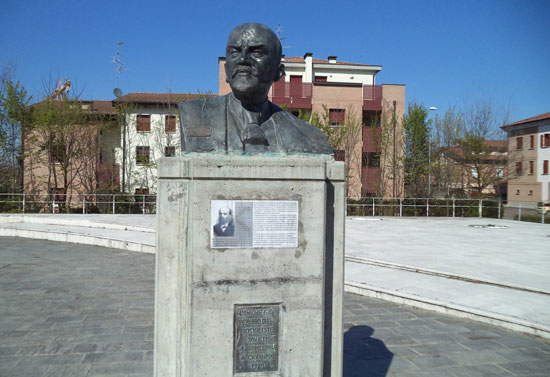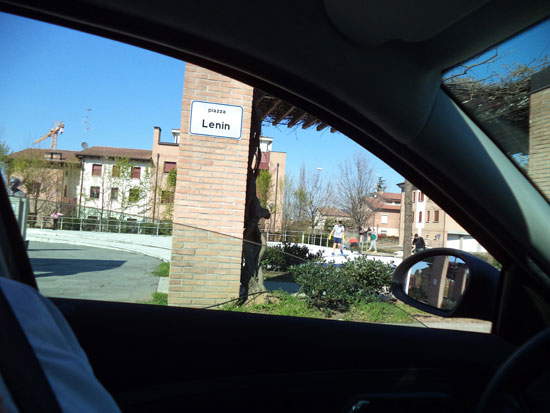Film adaptations of Giovannino Guareschi ’s books have given us the image of an Emilia somewhat stylized compared to the one that emerges from the texts, but nonetheless truthful: an Emilia divided between hard work in the countryside, Sundays at mass and faith in communism. The red Emilia, the region that more than any other in Italy has taken communism seriously, declined, however, of course, in its version with the flavor of lambrusco and gnocco fritto. A communism taken so seriously that in the end, for those who come to these lands and observe them with an analytical eye and without getting carried away, it is impossible to take it seriously. Little has changed from the postwar period to the present: the people of Emilia are still among the most hospitable and generous people in Europe, the spring evenings they spend between a polka and a mazurka in the dance halls at the edge of the fields are still alive, and the villages in the rural areas are the same as they were in Guareschi’s time, and have remained almost identical to how he described them. Clusters of one- or at most two-story houses, with the entrance on the edge of the main road, and where you find everything within a hundred meters: the newsstand, the mechanic, the grocery store, the tobacconist, the church, the party section.
Only the belief in communism is not the same as it once was. Ideology may still be alive in some people’s minds, but naiveté has given way to resignation. Emilia, too, has known administrators who professed to be communist and leftist but did everything but serve the interests of the people they administered and had everything at heart but the interests of the citizens. These lands too have known degradation, speculation, and mafia infiltration. And these lands have also known heavy disillusionment. Thus, if until a few decades ago practically all eligible voters went to the polls, at the last polls, last year’s regional elections, the overall turnout throughout the region was a paltry 37.70 percent: a tangible sign that politics is no longer a reference, a tangible sign that even in these parts distrust has reached levels never seen before, nor before now even conceivable. Those who govern this region today do so with not even 50 percent of the votes of a third of the voters. Therefore, it is not clear what or who he wants to represent.
We are in the countryside of the province of Reggio Emilia, “the most pro-Soviet of the provinces of the American empire,” as Giovanni Lindo Ferretti had to call it a few years ago. And here, too, in the reddest land in Italy, voter turnout stood at 35.98 percent. It has emerged in everyone’s eyes what Ferretti was sensing, with his strong sarcasm still understood by few, already twenty-eight years ago. Welfare, pleasure and ideology, the pillars on which the cheerful Emilians based their existence, have all been taken away. Today there is a beautiful spring sun over Cavriago, a village of farmers and workers about ten kilometers from the capital. And in light of all that has been said so far, the bust of Lenin that still makes a beautiful display in one of the town’s main squares cannot help but evoke a mixture of sympathy and nostalgia.
 |
| The bust of Lenin in Cavriago |
Actually, the bust today in Lenin Square is a copy: too many vicissitudes suffered by the original. So many that the administration opted to shelter the bust in what was once the City Hall and is now the Cavriago Cultural Center. Myth has it that Vladimir Lenin himself, in one of his speeches, specifically mentioned and praised Cavriago for its application of accomplished socialism. History and legend intermingle, but it is true that after the socialists won the elections in 1908, this little town unknown to most experienced important reforms: the administration was concerned with providing housing for the less well-off by building council houses, education became a priority and elementary schools were built to break down illiteracy, and the construction of an aqueduct was begun that could irrigate the land and quench the thirst of herds and people. Work however has always been a constant here. Hard work, first in the fields and then in the factories: it has been said that Reggio Emilia is only a few kilometers away, and Cavriago represented, in the postwar period, one of the natural industrial expansions of the capital. People worked, and then met in the Case del Popolo (People’s Houses ) to get together to talk about politics, about ways to change the world, perhaps starting in their own town, over a hearty snack.
 |
| The dedication on the bust of Lenin: Union of Soviet Socialist Republics to the people of Cavriago. |
What happened to the Soviet experience is there for all to see. How communism was misrepresented, too. Meanwhile, the application of socialism with a Reggio Emilia flavor continues to this day. Cavriago is the municipality that was the first in Emilia Romagna to open an artoteca, that is, a place where citizens can choose a work of art, borrow it for free, and keep it at home for a few days. Because “art is for everyone,” they specify on the municipality’s website, moreover allowing us at Finestre Sull’Arte to discover an unsuspected bond that unites us inseparably with the people of Cavriaghe, since we too have been saying for years that art must belong to everyone. A citizen should be able to enjoy art whatever “his salary, his job, his degree.” The library, in spite of what happens in other cities in Italy, even much larger ones, continues to be a center of aggregation. Cavriago has an expenditure on culture that is around 10 percent of the municipal administration’s budget: as a percentage, it is ten times what the state spends on culture. And under Lenin’s bust today, the town’s children play ball, old people chat, and young people rest after a day’s work. This is not a rhetorical postcard image: when we were in Cavriago in Lenin Square, this was truly the situation. Probably facilitated by the fact that the square is a very short walk from the center, as well as on the edge of a small park.
 |
| Time to go. From our car we wave goodbye to Lenin Square in Cavriago. In the background, children and young people are playing ball under a beautiful spring sun. |
It is very difficult today to look at Lenin’s bust for the ideals it embodies, partly because Soviet communism soon abandoned the groove Lenin had traced, partly because, despite this, Lenin too is associated with all the errors and horrors of the distorted applications of communism, and partly because the drifts that communism can take, which Noam Chomsky, among others, has spoken well about in his essays, has led many to look with distrust at this ideology. So today the bust of Lenin in Cavriago appears almost as a nostalgic symbol of an era when Italians had a somewhat more naïve and certainly more straightforward approach to politics, but looked forward to the future with confidence. A time when people were warmed by little, when they could still feel awe, and when almost everyone was inflamed because they believed in an idea. After all, those who believed in good faith, sincerely and unselfishly, in the ideals embodied by that bust, wanted nothing other than what we all hope for a little bit today, some more and some less consciously, and that is a just society, free of degradation and abuse, in which the interests of honest citizens come first.
Warning: the translation into English of the original Italian article was created using automatic tools. We undertake to review all articles, but we do not guarantee the total absence of inaccuracies in the translation due to the program. You can find the original by clicking on the ITA button. If you find any mistake,please contact us.